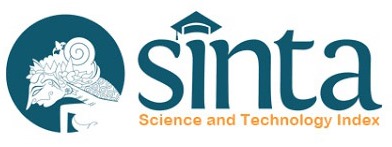Chitosan Composite of Crab Shell and Hydroxyapatite of Tuna Fish Bone as Biomaterials for Guided Tissue Regeneration
Thamrin Wikanta, Erizal Erizal, Sugiyono Sugiyono
Abstract
The needs of membrane biomaterials to prevent the migration process of epithelial cells into the bony area after tooth withdrawal process, for filler the holed tooth and to cure gingivitis have increased significantly. In this study, a biomembranes composed of chitosan (CTS) and hydroxyapatite (HA) were prepared. CTS was made of crab shell and HA was made of tuna fish bone. There were 4 groups of treatments, i.e.: K0: only 4 g CTS as a control; K1: combination of 4 g CTS and 2 g HA; K2: combination of 4 g CTS and 4 g HA; and K3: combination of 4 g CTS and 6 g HA. The dried and solid membrane was soaked in 5% Na2SO3 for 1 hour, and then dried in oven at 60 0C for 24 hours. The composite membrane properties, i.e.: water absorption, biodegradation, tensile strength, elongation at break, functional group (by FTIR), and microstructure (by SEM) were evaluated. Result showed that the increasing of HA content in membrane will decreasing the water absorption. The increasing of HA content in membrane and soaking time in Phosphate Buffered Saline (PBS), can increase in biodegradation rate. The biodegradation rate of membrane was about 4.44-6.01% during 27 days of soaking time. The increasing soaking time in PBS can decrease the tensile strength of membrane at about 18.33%-21.17% and decreased the elongation at break at about 26.64%-59.94%. FT-IR analysis indicated that there was a crosslinking between a CTS-HA composite membrane and Na2SO3. Among all the composites studied, CTS-HA (4/2 g/g) composite membrane is the best one for Guided Tissue Regeneration (GTR).
Keywords
biomembrane, chitosan, hydroxyapatite; tensile strength; elongation at break
DOI:
https://doi.org/10.15578/squalen.85
Refbacks
- There are currently no refbacks.

ISSN : 2089-5690(print), E-ISSN : 2406-9272(online)
This work is licensed under a Creative Commons Attribution-NonCommercial-ShareAlike 4.0 International License.










